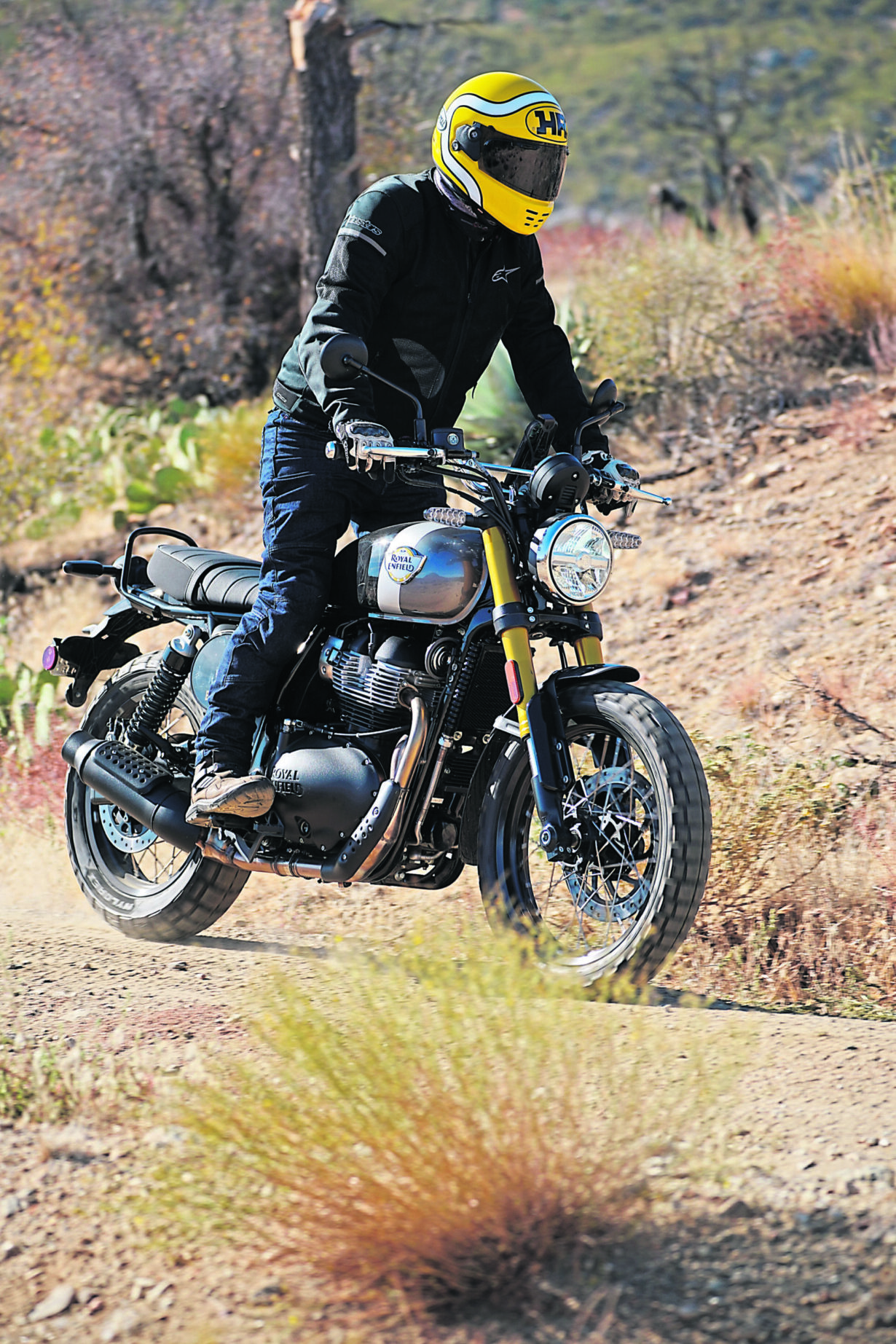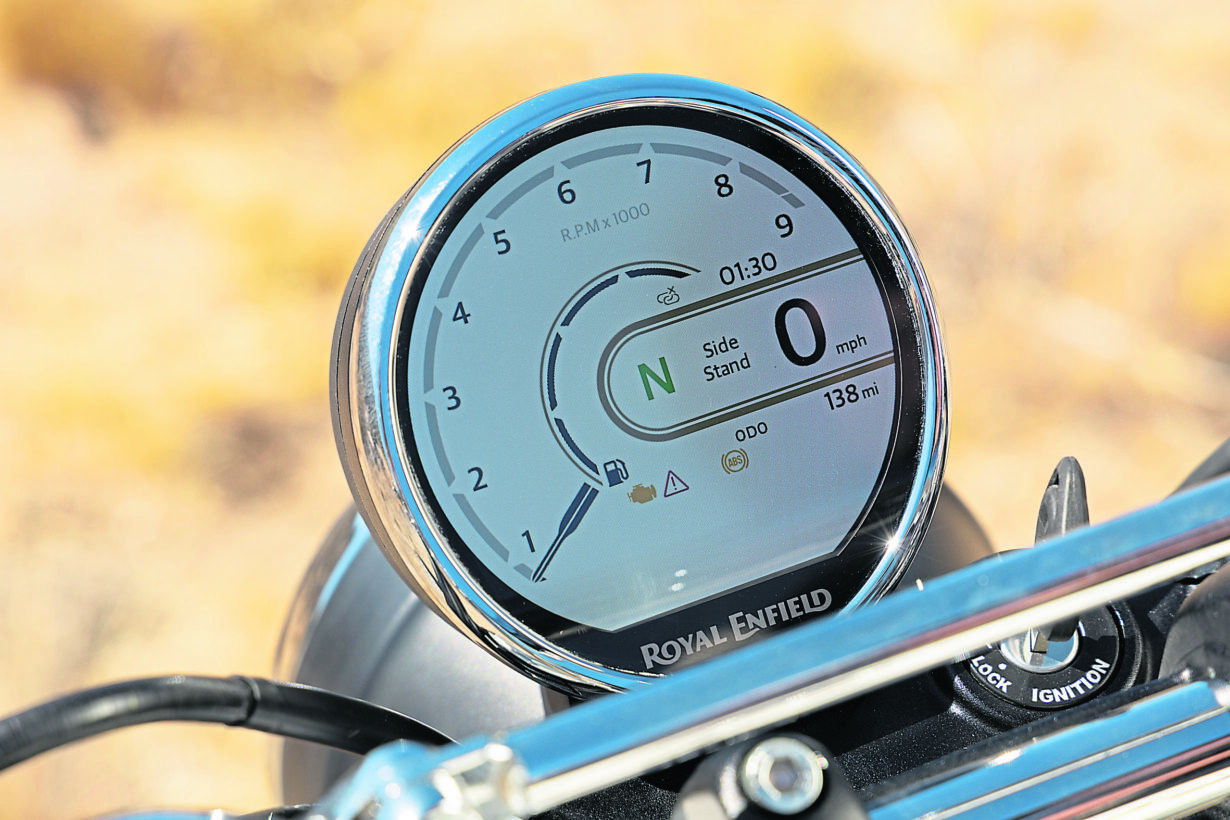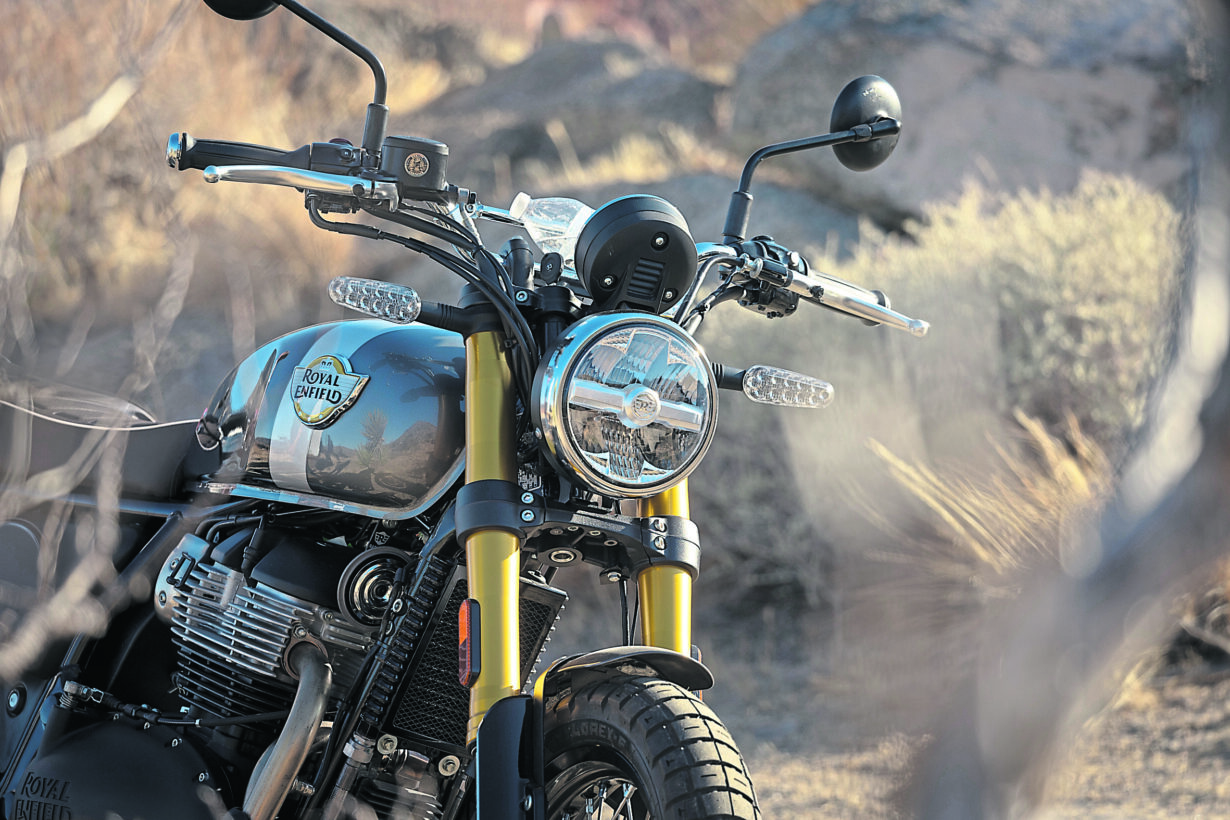Royal Enfield has been digging into its heritage again, this time celebrating a Californian desert race win with a modern scrambler take on its Interceptor 650 twin
It’s important to know your history. The popularity of TV programmes centred around celebs finding their ancestors testifies to this. As does the success of firms who’ll analyse the DNA in cells scraped from inside your mouth, then tell you that you’re 30 per cent Viking, 20 per cent Mongol warrior and 50 per cent middle-class bloke from Milton Keynes…
Companies know this, too. If you can point to a deep heritage in your area of business, then you can construct an interesting story around that, and maybe persuade folk that you’re not only after their money. You understand their passion, too – whether it’s for a fancy wristwatch, a malt whisky, a sports car or, of course, a motorcycle.
Enjoy everything MSL by reading the monthly magazine, Subscribe here.

Royal Enfield has a long and complex history. It regularly claims, with justification, to be the oldest brand of motorcycles in continuous production, starting out back in 1901 in Redditch. Now, of course, it’s an arm of the massive Indian automotive firm Eicher Motors. But it’s clearly proud of its heritage – it’s the only bike firm I know that brings its own official historian along to press riding launches (he’s a very nice man and knows A LOT about Royal Enfield…).
And that history is why I’m in Palm Springs, California (which has a bear as its state animal, of course), for a hectic 64-hour visit to the United States. We’re here to ride the new Bear 650 – a mild street scrambler, named after the Big Bear Run desert race which takes place near the town of Big Bear.
Back in 1960, a young 16-year-old racer called Eddie Mulder won the gruelling 150-mile, two-day event on a Royal Enfield 500 Fury. It was an incredible achievement for such a young rider, and catapulted Mulder to instant fame in the US desert race scene. And Mulder is here, as the Enfield staff unveil the new Bear 650, the 80-year-old racer sharing his memories, and shedding a tear or two.

Emotional stuff. But we’re here to check out this new bike, so I give it a once-over up on the display stand at the presentation. Like the Classic 650 Twin I rode before, it’s definitely a handsome piece of kit. Enfield has nailed the paint, finish, style and quality really well now, and I’m taken by the deep colours on the tank and side panels, as well as the purposeful stance given by the 19-inch front wheel and the slightly taller suspension. Details like the embossed tank badge, chromed fuel cap and branded LED headlamp have a really rather premium feel; the round full-colour LCD dash lends an air of sophistication; and the Showa labels on the gold-anodised upside-down front forks promise sharp handling.
The blacked-out engine looks good, too – though I’m already concerned about the lack of any mention of upgrades to the powertrain. A two-into-one silencer marks this bike out from the other 650 twins, which all have twin cans, but I’m surprised it’s a conventional low-slung pipe rather than a slick high-level design which would be more in keeping with the 1960s scrambler ethos. The black-painted can also looks a bit less premium than the rest of the design.
Next morning, after about four hours of sleep, my jet-lagged brain is trying to remember what day it is as I climb on board the Bear for the test ride. We’ve got a fairly long day ahead of us, with a route of nearly a couple of hundred miles, up into the mountain roads south of Palm Desert. The weather is perfect, with not a cloud in the sky, and I’m looking forward to a proper ride.
The Bear has a decent seat height, a little higher than the likes of the Interceptor, but no problem even for my relatively stumpy 30-inch inside leg. The black-finished aluminium Enfield switchgear and controls are familiar enough, as is the off-beat idle from the air-cooled 270° parallel twin motor underneath me. What’s new is the dash: a large, round, stylish LCD panel, with a crisp, clear display. It has the feature I hate on many new bikes, though: the turn signal indicator is just an easily missed green arrow icon on the LCD, rather than a separate bright LED bulb, meaning I (and almost everyone else) leave the indicators on too long all day.

We’re off now, though, and following one of Enfield’s notoriously capable test riders (this one generally spends June on an island in the Irish Sea…) off down the highway, then up into the hills. On the fast highway section, the Bear is much like its siblings: there’s basically no wind protection; the engine is just about powerful enough to keep up with traffic; and the riding position is comfy enough. Is it ideal for tackling 40 miles of the M40 on a cold, miserable autumn morning? Probably not, but the Bear would certainly do the job.
Luckily, we’re not on the straight and narrow Route 10 for too long, and before I nod off, we take the next turn and are soon charging up a fairly fast, quiet, twisting mountain road. My sleepy synapses are groggily grappling with the situation, but the Enfield man is off, and I have to really put some effort in to keep him in sight. I come round one tight horseshoe bend, and the low Californian sun hits me right in the retinae, temporarily blinding me, even through my Arai’s dark visor. The shock and mild terror as I wobble round the corner, with nothing at all in sight, wakes me up, at last…
Over the next few hours, we take in some amazing stretches of asphalt, and the Bear 650 behaves itself nicely. The steering is easy and instinctive despite the bigger 19-inch front wheel; it’s easy to throw the bike over on its side; and there’s decent ground clearance, too. The engine is just about up to the job, but when you’re heading uphill, the throttle is absolutely jammed against the stop at 100 per cent the whole time, and I’d definitely like a bit more go. It’s not a bad engine – I’ve written a few times now about how pleasant the torque curve and fuelling are – but the low peak output is definitely a limiting factor.

Conversely, on downhill sections the situation is reversed: now you’re relying on the brakes a bit more, and again, they’re just about up to the job. The Bear’s no lightweight at 214kg, and having just one disc up front, with a twin-piston caliper feels a bit stingy, even on a 60s-style street scrambler. The suspension is a little curious, too. That handsome Showa front fork feels a bit too firm, skipping and bouncing if you happen to hit a pothole or clip one of the chunky cat’s-eyes in the middle of the road. But the front end feels good on the brakes, and the rear end is better all round, with a plusher feel.
At the end of the day, Enfield engineers also suggested that they were still working on final suspension settings, and were taking feedback, so full production machinery might have a tweak or two there. Those mild dirt-style MRF (Madras Rubber Factory) tyres work fine, but with warm and dry desert Tarmac all day, you’d probably expect that. The weight and geometry make for a stable ride, and once you get into the groove, it’s easy to maintain decent corner speeds round the wide, sweeping curves up in the San Jacinto State Park.
We’re well out into the sticks now and are heading for a small off-road test area for some pics. It’s not much more than a mile or so of dry desert road, with some deeper sand sections, so a fairly gentle test. And the Bear does okay. It’s by no means a serious off-road machine, with just 130mm front suspension travel and 115 rear to handle its 214kg mass, together with those MRF road tyres and their mild dirt pretensions. For the odd gravel road or (dry!) green lane, though, you’ll be able to potter along without too much grief.
So, at the end of a very nice day in California, what was the final impression of the Bear 650? On the plus side, it’s a handsome piece of kit indeed. Glinting in the golden desert light, the premium-finished alloy parts, gold-anodised forks, and deep, shiny paint look the absolute business, and totally belie the budget price tag. The spec sheet is scant when it comes to fripperies like IMU-assisted rider aids, massive colour screens, cruise control, quickshifters and the like – but that’s not what you buy an Enfield for.
As a dynamic experience, it falls down a little on some basics: 46bhp simply isn’t enough power for a 214kg bike in 2025 I’d suggest, and while the firm says it wants to stick to the A2 licence power limits, the subtext is that they’re happy to work to the Indian market, where 46bhp is a lot. On UK roads, I’d definitely prefer an extra 15-20 ponies, but even an extra 10 would put the 650 Enfields back in the race. The chassis would cope – but would be even better with another brake disc on the front end, or at least with a four-piston brake caliper (which even the most basic Chinese 125 seems to come with these days).
As with the whole Enfield range, though, the massive tick for the Bear comes with the price tag. Starting at just £6749 for the Petrol Green paint scheme, rising to £6849 for the black/gold silver Golden Shadow paint, and £6949 for the ‘249’ Eddie Mulder replica, the latest Enfield 650 is cracking value. In comparison, a Ducati Scrambler 800 starts at £9500 and the Triumph Street Scrambler 900 from £9795, both around £3k more, albeit for much more capable engine and chassis packages.
When you consider the styling and the feel of the Royal Enfield Bear 650 though, it’s much closer than a simple spec-sheet comparison makes it. And if you factor in that almost indefinable heritage and history, the Bear is right back in contention.
A bit more detail…
Frame
Based on the Interceptor 650’s steel tube cradle design, but with some extra bracing at the steering head to suit the new taller USD front forks. The geometry has been tweaked as well, with a longer rear swingarm. The most obvious change to the frame is at the back of the seat, where there’s a new upward sweep to the rear subframe loop.
Engine
The same 648cc parallel twin SOHC 4-valve air-cooled motor that I rode back in 2018 on the Interceptor and GT650 launch in northern California, pretty much. The 2025 version has been fettled for Euro5+ emissions compliance, and the Enfield folks say the two-into-one exhaust system adds some low-down torque, but the peak power remains at the A2-friendly 46bhp.
Electronics
LED lighting, colour LCD dash with navigation and media connections, USB-C charging port, dual-channel ABS with switchable rear, and that’s pretty much it. No traction control or rider power modes here.
Running gear
Showa Big-Piston forks have 130mm travel but no adjustment, and there’s preload adjustment only on the 115mm-travel Showa twin-tube rear shocks. Single brake discs at each end, 320mm front and 270mm rear, are paired with dirt-style twin-piston sliding calipers by Brembo’s Indian arm, ByBre.
Wheels/Tyres
Tube-type wire-spoked wheels are shod with MRF (Madras Rubber Factory) Nylorex dirt-styled tyres. The front wheel is a 19-inch rim, for a little more off-road capability, without affecting road handling too much.
Colours
Sadly, the UK isn’t getting some of the most attractive colour schemes – we get the Petrol Green, Golden Shadow and Two Four Nine schemes (249 was Eddie Mulder’s race number in 1960). The white/blue/orange and the black/yellow schemes are only available in other markets, which is a shame: the black/yellow in particular is really handsome in the flesh.
SPECIFICATION: Royal Enfield Bear 650
Engine: SOHC 4v, parallel twin, air-cooled, 648cc, 78×67.8mm bore/stroke
Max power: 46bhp (34.3kW) @ 7150rpm
Max torque: 41.6lb-ft (56.4Nm) @ 5150rpm
Frame: Steel tube double cradle
Wheelbase: 1460mm
Rider aids: Connectivity to phone & Tripper sat-nav, switchable ABS
Brakes: (F) Single 320mm disc, twin-piston sliding axial-mount caliper, (R) 270mm disc, twin-piston sliding caliper, dual channel ABS, switchable on rear
Transmission: Six speed gearbox, wet clutch, chain final drive
Suspension: (F) 43mm USD Showa Big Piston front fork, non-adjustable, (R) Steel swingarm, preload-adjustable Showa twin shocks
Wheels/Tyres: (F) Wire-spoke tube type, 100/90×19” MRF tyre, (R) Wire-spoke tube type, 140/80×17” MRF rear
Seat height: 830mm
Fuel capacity: 13.7 litres
Weight: 214kg
Warranty: 3 years unlimited mileage
Contact: www.royalenfield.com
Price: £6749-£6949, depending on colour






